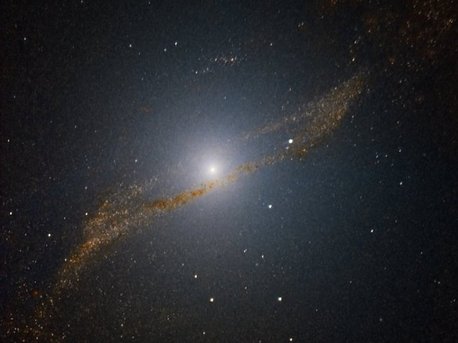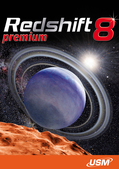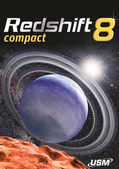Watching a Cannibal Galaxy Dine
Galaxies High Up In The Food Chain
 © ESO/Y. Beletsky |
This image of the central parts of Centaurus A reveals the parallelogram-shaped remains of a smaller galaxy that was gulped down about 200 to 700 million years ago.
Herschel could not know, however, that this beautiful and spectacular appearance is due to an opaque dust lane that covers the central part of the galaxy. This dust is thought to be the remains of a cosmic merger between a giant elliptical galaxy and a smaller spiral galaxy full of dust.
Between 200 and 700 million years ago, this galaxy is indeed believed to have consumed a smaller spiral, gas-rich galaxy — the contents of which appear to be churning inside Centaurus A's core, likely triggering new generations of stars.
First glimpses of the “leftovers” of this meal were obtained thanks to observations with the ESA Infrared Space Observatory , which revealed a 16,500 light-year-wide structure, very similar to that of a small barred galaxy. More recently, NASA’s Spitzer Space Telescope resolved this structure into a parallelogram, which can be explained as the remnant of a gas-rich spiral galaxy falling into an elliptical galaxy and becoming twisted and warped in the process. Galaxy merging is the most common mechanism to explain the formation of such giant elliptical galaxies.
What the astronomers found in the new images was surprising: “There is a clear ring of stars and clusters hidden behind the dust lanes, and our images provide an unprecedentedly detailed view toward it,” says Jouni Kainulainen, lead author of the paper reporting these results. “Further analysis of this structure will provide important clues on how the merging process occurred and what has been the role of star formation during it.”
The research team is excited about the possibilities this new technique opens: “These are the first steps in the development of a new technique that has the potential to trace giant clouds of gas in other galaxies at high resolution and in a cost-effective way,” explains co-author João Alves. “Knowing how these giant clouds form and evolve is to understand how stars form in galaxies.”
The new image of Centaurus A is a wonderful example of how frontier science can be combined with aesthetic aspects.
Source: ESO
Watching a Cannibal Galaxy Dine
Galaxies High Up In The Food Chain
 © ESO/Y. Beletsky |
This image of the central parts of Centaurus A reveals the parallelogram-shaped remains of a smaller galaxy that was gulped down about 200 to 700 million years ago.
Herschel could not know, however, that this beautiful and spectacular appearance is due to an opaque dust lane that covers the central part of the galaxy. This dust is thought to be the remains of a cosmic merger between a giant elliptical galaxy and a smaller spiral galaxy full of dust.
Between 200 and 700 million years ago, this galaxy is indeed believed to have consumed a smaller spiral, gas-rich galaxy — the contents of which appear to be churning inside Centaurus A's core, likely triggering new generations of stars.
First glimpses of the “leftovers” of this meal were obtained thanks to observations with the ESA Infrared Space Observatory , which revealed a 16,500 light-year-wide structure, very similar to that of a small barred galaxy. More recently, NASA’s Spitzer Space Telescope resolved this structure into a parallelogram, which can be explained as the remnant of a gas-rich spiral galaxy falling into an elliptical galaxy and becoming twisted and warped in the process. Galaxy merging is the most common mechanism to explain the formation of such giant elliptical galaxies.
What the astronomers found in the new images was surprising: “There is a clear ring of stars and clusters hidden behind the dust lanes, and our images provide an unprecedentedly detailed view toward it,” says Jouni Kainulainen, lead author of the paper reporting these results. “Further analysis of this structure will provide important clues on how the merging process occurred and what has been the role of star formation during it.”
The research team is excited about the possibilities this new technique opens: “These are the first steps in the development of a new technique that has the potential to trace giant clouds of gas in other galaxies at high resolution and in a cost-effective way,” explains co-author João Alves. “Knowing how these giant clouds form and evolve is to understand how stars form in galaxies.”
The new image of Centaurus A is a wonderful example of how frontier science can be combined with aesthetic aspects.
Source: ESO








